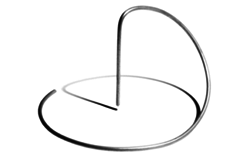

Distance proof
In his series of self-portraits, Christian Peter stages himself in a multiple mode, embodying several characters in theatrical situations that evoke the frailty or the anticipated demise of the artist. Very short stories, as it were. In their various appearances, Me, Myself and I are both tragic and pathetic. The lines created by the characters’ gazes within the space of the photograph build that space and reveal a great distance between the author of the photograph and the tragedy depicted.
The same distance is at play in the whole work of Christian Peter. For the 2013 series Factory Telling, he returned to the sites of the plants he knew before their shutdown in order to capture the play of light on architectural surfaces. Diamond-like reflections, the walls take on a golden or silvery tint. What remains from these walls is the swan song of the factories rendered inactive, fragments of an incredibly pictorial and graphic world.
This almost abstract work of graphic composition is at the core of Christian Peter’s work.
In Abstracting Forms, he superimposes the close and the distant of a same landscape. The combination of the two images and the shift from color to black and white give rise to a third image that is much more than the sum of the original two. The landscape turns into a surface whose matter seems to become a dense, mobile and mercury-like shimmering liquid: quicksilver. The ground liquefies and the horizon blurs.
Several series, in particular Horizon Tales, explore and play with multiple ways of distorting the skyline, culminating in the radicality of The Fall, initiated in 2017, which replicates the line drawn by the dam in Breisach am Rhein, shot from the same viewpoint in different seasons. Here also, we can experience the picture division, the brilliance of surfaces, the pictorial dimension and the abstraction at play in Factory Telling.
More explicitly entitled, Memento Mori gathers colour photographs taken at different times and places, fixing the impermanence of things through a fragment of sky fallen into a field, a fish seemingly leaving the water for the clouds, the horizon tilting onto a road construction site or a boat (?) sinking into a canal.
In an opportunistic but sensitive manner, either in a grace-filled moment where everything conspires to give him the image, or by patiently watching for the moment when the weather and the position of the sun will be advantageous, he thus captures the moment and the movement of a beautiful wreck.
This repetitive and aesthetic dimension applies in the animated slideshow of the Blackbird, which in a strange and absurd way, desperately wants to step across the window glass behind which the photographer captures the expression of this obstinate vitality as a mirror image of his own work.
Evelyne Loux